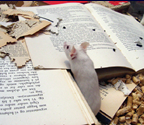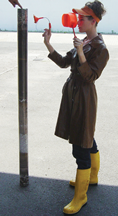November 10, 2006
Interface and Society

AbA Logic + Superconsumer
AbA Logic by Art by Accident (Kalle Grude, Jan Løchstøer) :: Six Muses of Randomness: Six white mice reside among books on logic subjects inside a laboratory cabinet. What are they doing there? Well, obviously they are nibbling on the books. Apparently they are nesting, as in quiet moments they cuddle up in a ball beneath snippets of logic. As they wander among the books they trigger a databank of words connected to electronic boards. The boards make up two sentences of three words each (so-called AbA-logic statements). Each time a mouse triggers a sensor, a new statement appears. The words (adjectives, adverbs and nouns) are common in logic terminology. The statements that appear are less common. This is why they are of interest to us.
In order to materialize this constant stream of statements, they are printed as they appear. On AbA’s desk piles of sketches and notes from the process accumulates. In addition to participate in a digital process, the mice -through their nibbling- are creating sculptural rephrasing of the books, and produce new combinations of the texts and illustrations from the pages of the books.

Superconsumer by Franz Alken and Karl Rueskaefer :: What happens when a computer programme starts buying and selling stuff on Internet auctions like ebay autonomously? That is the key question of superconsumers. The stuff the Bot has bought is exhibited for a short time. Thus digital values are translated into tangible goods. And vice versa, since the Bot sells them again after a while to buy new ones. In this way, commonplace products are temporarily translated into works of art.
The basic principle of superconsumers, is to make an amount of money available to a software (a so called “bot”). The software uses this money to buy goods autonomously at the online-auction-platform ebay, transfers these goods to an art-space, exhibits them and sells them again via ebay. The exhibition-module consists of a computer-interface displaying the softwares actions at ebay, 7 pedestals that show the current goods and a watchmann who executes the software’s instructions and arranges the goods on the pedestals. There are mainly 4 points that form a fascintation for this project: The relationship between humans and machines - the bot replaces exemplarily the role of humans in the ebay environment.
The ready-made principle: While transferring ordinary objects from the mass-market to an art space, the bot enhances the objects to pieces of art. This enhancement is temporarily, the bot takes away the “art aura” by selling these pieces again via ebay.
The installation gives a constantly updated overview on the mass-market. The programming of the process makes the items the bot will buy unpredictable - a search on the topic “football” can respond items like fan-articles, computer games, books or sportswear. Interaction is an important point on art-projects dealing with the internet. The interaction at superconsumers is quite hidden: Everyone dealing with the bot at ebay is arranging the exhibition without knowing it.
More about Interface and Society [PDF]
Posted by jo at November 10, 2006 04:57 PM
